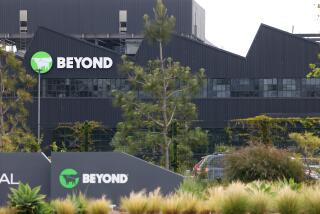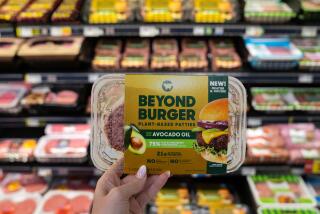Marketing Beef Proves to Be a Difficult Task
- Share via
“Beef: Real Food for Real People” just doesn’t do the job. Maybe it’s because spokesman James Garner went down with quintuple-bypass heart surgery. Or because spokeswoman Cybill Shepherd was quoted as saying that she, well, never really ate much of the stuff.
Or maybe the real fault lies in how beef is sold--as a commodity, not a series of specific products. Combine that with generic advertising’s spotty record and chicken’s soaring popularity and what do you have: The lowest consumption of beef in 25 years, a mere 77 pounds per capita in 1987, the most recent statistics available.
“The value of advertising a generic product (beef) is generally considered to be less effective than brand name advertising,” said a recent study by the National Cattlemen’s Assn.
One solution to the problem is so-called branded beef, a seemingly simple concept. Slap a handle on your hamburger and hope that the public will bite. Sounds logical, for after all, nearly everything else is sold that way.
But so far, the concept has not taken off. The cattlemen’s association study blames economics: “Development of new, differentiated (brand-promoted) products consistent with consumer preference for convenience is slowed as packers strive to maintain volume and margins at the expense of research and development.”
To John Francis, executive vice president of marketing for the National Live Stock and Meat Board, the problem is that major meatpackers just haven’t progressed very far along the “learning curve.”
“A couple years ago there were three or four dozen branded products,” Francis said. “Now there’s under a dozen. That’s an indication of the kind of learning curve our industry has to go through. . . . Right now, I’m not sure (branded beef) measures on the Richter scale. In the total scheme of things it’s very, very small.”
Over the past five years, Monfort Inc., a subsidiary of ConAgra, has poured nearly $1 million into the research and development of branded products. The results have been dismal.
The firm has three failures under its belt, has never gotten a branded product past the test-market stage and currently has no branded product on the market, said Joseph Meilinger, Monfort’s vice president for marketing.
Monfort Cooked Meats--a line of prepackaged meat loaf and barbecued ribs--debuted and died in 1985. Prepackaged, retail-ready lamb, all vacuum packed and bearing the Monfort American Gourmet label, was unveiled in 1987 and withdrawn in 1988. In that same time frame, the company tried out a labeling program called Monfort Gold, but only one market chain opted to decorate its meat packs with the company’s labels. And not for long.
“We’ve tried different things,” Meilinger said. “They haven’t been successful. We are not daunted. We will continue to work with the retailers and consumers and bring them a product. . . . But the American consumer is very difficult to please in this area. You can’t just sell them a pig in a poke.”
With 42 items from brisket to top sirloin steak in its product line, Excel Inc. is the only Big Three meatpacker that currently offers customers branded beef. At the behest of Kroger Inc., a major supermarket chain, Excel launched its branded beef in Kroger markets in 1986.
“The one way, and a significant way, to influence demand for beef is to differentiate it from other products,” said Herbert Meischen, Excel’s vice president for marketing. “The only tool in most markets is price and item, like offering the chuck roast this week at $1.29. If you want a big piece, you get a big un’. If you want a small one, you get a small un’.”
More differentiation is necessary, gives you something to advertise and just is what Excel offers throughout the South, Meischen said. While Excel will not divulge specifics, Meischen said the branded items are doing well.
But few branded beef concerns are as successful as Coleman Natural Meats Inc., a Denver firm that sells antibiotic-free and hormone-free beef and lamb in 35 states and had $20 million in sales in fiscal 1989.
The company started selling natural beef to retailers in 1979, but did not come out with a line of prepackaged meats until five months ago. What that means is that, originally, you could wander into a Mrs. Gooch’s Natural Foods Market and find slabs of Coleman beef that were cut into saleable form by a butcher.
With the prepackaging program, cut, wrapped and labeled meats are delivered to markets for display in regular refrigerator counters. Four market chains currently offer prepackaged Coleman Natural Beef, said Mel Coleman Jr., the company’s director of sales and marketing.
“Our whole program is designed around producing natural and organic food products raised using ecologically focused principles,” Coleman said. “The reason we’re doing prepackaging is because, like the rest of the industry, that’s where we think the future is going to be.”
More to Read
Eat your way across L.A.
Get our weekly Tasting Notes newsletter for reviews, news and more.
You may occasionally receive promotional content from the Los Angeles Times.











